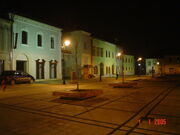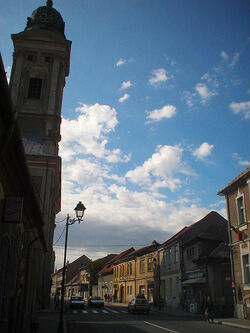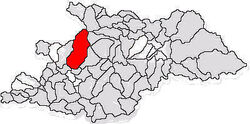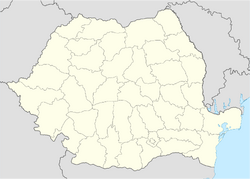| Main | Births etc |
|---|
| Baia Mare Hungarian: Nagybánya German: Frauenbach, Neustadt, Frauenseifen Ukrainian: Бая-Маре/Baya Mare| Latin: Rivulus Dominarum |
|||
|---|---|---|---|
| View of the historic center of Baia Mare | |||
|
|||
| Location of Baia Mare in Maramureş County | |||
| Coordinates: | |||
| Country | |||
| County | Maramureş County | ||
| Status | County capital | ||
| villages | |||
| Government | |||
| • Mayor | Cătălin Cherecheş (National Liberal Party/Social Liberal Union) | ||
| Area | |||
| • Total | 233.3 km2 (90.1 sq mi) | ||
| Elevation | 228 m (748 ft) | ||
| Population (2011)[1] | |||
| • Total | 120,270 | ||
| • Density | 641/km2 (1,660/sq mi) | ||
| Time zone | EET (UTC+2) | ||
| • Summer (DST) | EEST (UTC+3) | ||
| Website | http://www.baiamarecity.ro/ | ||
Baia Mare (Hungarian: Nagybánya; German: Frauenbach, Neustadt, Frauenseifen; Ukrainian: Бая-Маре/Baya Mare|; Latin: Rivulus Dominarum) is a municipality in northwestern Romania and the capital of Maramureș County. The city is situated about 600 kilometres from Bucharest, the capital of Romania, 70 kilometres from the border with Hungary and 50 kilometres from the border with Ukraine. The city administers four villages: Blidari, Firiza, Valea Borcutului, and Valea Neagră.
History[]
Prehistory[]
The city's development on the middle course of Săsar River, in the middle of a plateau with a warm Mediterranean-like climate, has facilitated living conditions since the Palaeolithic.
Ancient times[]
During the Bronze Age the region was inhabited by Thracian tribes. Later, it was included in the Dacian Kingdom formed by the King Burebista when the mining exploration began, as the area is rich in gold and silver.
Middle Ages[]
Baia Mare is first mentioned in written documents released by Charles I of Hungary in 1328 under the name of Rivulus Dominarum (English: Ladies' River).
Later, in 1347 the town is presented in documents by Louis I of Hungary as an important medieval town with a prosperous mining industry. Its rules of organisation were characteristic of the free towns of that time. In 1411 the town and its surrounding areas, including the mines, were transferred into the property of the Hunyadi family by Sigismund, the Holy Roman Emperor, who recognised Janos Hunyadi's contribution to stop the Turkish invasion of Western Europe.
The town entered in a period of prosperity, when St. Stephen Cathedral was built. Today the cathedral tower is one of the best-known of the town's historic landmarks (see Stephen's Tower). The first school, named Schola Rivulina, was opened in Baia Mare in 1547 by the Reformed Church following the Protestant Reformation.
Modern period[]
In 1703 Pintea Viteazul and his band managed to free the town for a short period of time from the Holy Roman Empire, for which it served as the imperial treasury. Since then Pintea has been seen as an important figure in the town's history, representing the dream of freedom. The Budești Church has his chain mail shirt and a helmet reportedly worn by "Pintea the Brave", as he was called. The Museum of Baia Mare displays his weapons and their harness.
In 1748 the city’s mining industry made a leap forward when the Austrian authorities created the headquarters of "Superior Mining".
In the late nineteenth century, Simon Hollósy, István Réti, János Thorma, and Károly Ferenczy were among numerous young Hungarian and Romanian artists who left the area to study at the Munich Academy in Bavaria, because the Austro-Hungarian Empire lacked an art academy. In 1896, they decided to settle together in Baia Mare, then called Nagybánya, to work on art. Their artistic colony became known for a significant movement influencing the development of twentieth-century Hungarian art. Works by each of these important painters is held by the Hungarian National Gallery in Budapest.[2]
Following World War I, the Austro-Hungarian Empire was dissolved, and in 1919, Baia Mare was annexed by the Kingdom of Romania. It was re-occupied by Hungary between 1940-1944 but returned to Romania after World War II. Shortly after World War II in postwar development, the town of Baia Mare started to grow in both population and inhabited area. In the late 1970s and early 1980s, a new town centre was developed with modern architecture buildings and structures.
In 2000, Baia Mare was the site of what has been considered Europe's worst ecological disaster since Chernobyl.[3] The tailing dam at a gold processing plant broke and 100,000 cubic meters/70 tons of toxic cyanide and heavy metal-laced waste water escaped into the River Tisza and into Hungary, making its way into the Danube and affecting Romania, Hungary, Ukraine, Serbia, and Bulgaria.[3] More than 1,400 tons of fish, numerous eagles, storks and otters all died.[3] Scientists also fear the release may have led to the ultimate extinction of at least five fish species.[4] Despite the accident's happening in Romania, much of the impact was felt in Hungary. The accident prompted Hungary to ban the use of cyanide in gold processing and urge the rest of Europe to do the same.[5]
Geography[]
The city is situated in the vicinity of the Gutâi and Igniș Mountains. Altitudes reach 1400 meters in some peaks. The area is famous for its outstanding landscapes, and the mountains are easily accessible from the city, famous routes being: Igniș (1307 m), Mogoșa (1246 m), Gutâi (1443 m), Creasta Cocoșului (1450 m), Piatra Șoimului (839 m), Pleștioara (803 m), Dealul Bulat (683 m), Murgau (633 m), Dealul Crucii (500 m) etc. Some of these mountains provide skiing slopes, most notably the one at Mogoşa, which is the most difficult slope in Northern Romania.
The city is situated in the Baia Mare valley and is encircled on all sides by hills and mountains, which makes the climate in the city milder than the rest of the surrounding area. Proof of this is that the outskirts of Baia Mare are the only areas where you can find chestnut trees that usually need Mediterranean climate to grow. This is the northernmost reach of the chestnut tree.
However, abrupt temperature changes take place and, during the winters, the temperatures may occasionally drop below -20 degrees Celsius. The summers are mild, cooler than in the rest of the country. The precipitations in this area are quite high, due to the mountains in the north and east which do not allow the air masses to pass beyond the region's limits, the average rainfall being almost 1000 mm/year.
The city of Baia Mare is the most populous of Northern Romanian cities (Satu Mare, Suceava and Botoșani), with a population of approximately 149,735. It also has high a level of culture and education, being home to theatres, schools, museums and art galleries. Not far from the city there are a few very important natural reservations, among them Creasta Cocoşului, Cheile Tătărului, Lacul Albastru etc.
Because of its privileged location in the Eastern Carpathian mountains it is considered one of the most picturesque cities in Romania.
Demographics[]
The municipality of Baia Mare had a total population of 137,921 in 2002, the majority being Romanians. The ethnic composition of the city is as follows:
- Romanian: (79.81%)
- Hungarian: (14.84%)
- [Gypsies]]: (0.51%)
- German:(0.36%)
- Ukrainian: (0.25%)
- Jews: (0.10%)
and 642 others, including Greeks, Turks, Italians, Lippovans, Poles and Slovaks.
Before the Second World War, Baia Mare had a community of more than 1.000 Jews, out of which only around 130 still live in the city, due to the deportation and extermination of the Jews in the Holocaust during the Hungarian occupation of Northern Transylvania. Along with Rădăuți, Gura Humorului and others, Baia Mare was one of the country's shtetls. There is a synagogue dating from 1885.
Politics[]
The Baia Mare Municipal Council, elected in the 2008 local government elections.
| Party | Seats in 2004 | Seats in 2008 | Current Council | |||||||||
|---|---|---|---|---|---|---|---|---|---|---|---|---|
| National Liberal Party | 9 | 9 | ||||||||||
| Democratic Liberal Party | 5 | 6 | ||||||||||
| Social Democratic Party | 4 | 5 | ||||||||||
| Democratic Union of Hungarians in Romania | 3 | 3 | ||||||||||
| Greater Romania Party | 2 | - | ||||||||||

Street in Baia Mare
Economy[]
The economic activity of Baia Mare has been based on the mining activities located in the surrounding areas. However, after the 1989 Revolution and industrial changes, such mining declined considerably. They have been replaced with several activities which have improved the city's economy in recent years. Baia Mare has become one of the most economically evolved cities in the region. As a result, several supermarkets have been built in the city and at least two shopping malls are due to open no later than December 2010. The largest sofa manufacturing plant in Eastern Europe, Italsofa, is located near the Baia Mare city highway ring.
The road infrastructure within the city is changing to be able to better connect the city and absorb the traffic. An express road is to be built between Petea (at the border with Hungary) and Baia Mare, a project for which the feasibility study has just completed. The express road will connect the cities of Baia Mare and Satu Mare to the Hungarian motorway M3, and thus to the whole European motorway network.
Natives[]
Sportsmen[]
|
|
Singers and actors[]
- Clara G
- Paula Seling
Painters[]
- István Réti
Others[]
- Gheorghe Costin - composer
Famous residents[]
Others[]
- Augustin Buzura - Romanian novelist
- Gheorghe Pop de Băsești - Transylvanian politician
- Mstislav Dobuzhinsky - Lithuanian painter
- Amrita Sher-Gil - Indian painter
- János Thorma - Hungarian painter
- Mária Földes - Romanian born Jewish playwright
- Maricel Voinea - Handball player, Olympic medals winner
International relations[]
Twin towns — Sister cities[]
Baia Mare has signed town twinning agreements or partnership agreements with the following cities:
Serino, Italy, since 2003
Nyíregyháza, Hungary, since 2003 - partnership only
Hódmezovásárhely, Hungary, since 2001
Bielsko-Biała, Poland, since 2001
Hollywood, USA, since 2001
Wels, Austria, since 2000
 Ivano-Frankivsk, Ukraine, since 1990[6]
Ivano-Frankivsk, Ukraine, since 1990[6]Szolnok, Hungary, since 1990
 Kitwe, Zambia, since 1972
Kitwe, Zambia, since 1972 Combs-la-Ville, France, since 2009
Combs-la-Ville, France, since 2009
Structures[]
- Chimney of Phoenix Copper Smelter, height: 351.5 metres, which is the tallest structure in Romania.
References[]
- ^ Recensamant: Populatia judetului, in scadere, [1], 2011
- ^ "Munich in Hungarian, Hungarian Artists in Munich 1850-1914, 2 Oct 2009 - Jan 2010", Hungarian National Gallery, accessed 6 Sep 2010
- ^ a b c http://www.allacademic.com/meta/p_mla_apa_research_citation/1/0/9/1/8/p109181_index.html
- ^ "Report of the International Task Force for Assessing the Baia Mare Accident" available at http://www.reliefweb.int/library/documents/eubaiamare.pdf
- ^ http://sofiaecho.com/2010/02/02/851712_hungary-urges-europe-wide-ban-on-cyanide-mining-technology
- ^ "Офіційний сайт міста Івано-Франківська" (in Ukrainian). mvk.if.ua. http://www.mvk.if.ua/news/4114/. Retrieved 7 March 2010.
External links[]
- Official website
- Baia Mare on Placeopedia
- University of Baia Mare
- Photos of the city and its surroundings in the dedicated Flickr group
| ||||||||

|
Certeze | Săpânța | Ocna Șugatag | 
|
| Negrești-Oaș | Baia Sprie | |||
 Baia Mare | ||||
| Tăuții-Măgherăuș | Recea | Groși |
| |||||||||||||
| ||||||||||||||
| |||||||
| This page uses content from the English language Wikipedia. The original content was at Baia Mare. The list of authors can be seen in the page history. As with this Familypedia wiki, the content of Wikipedia is available under the Creative Commons License. |





